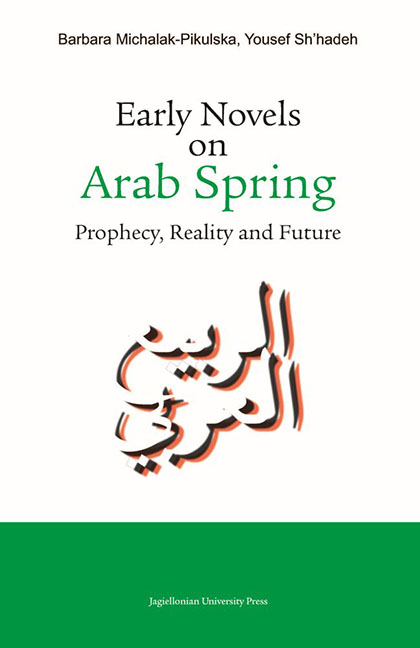Book contents
- Frontmatter
- Contents
- Introduction
- Part I Awakening of the Awareness of Subjugation – The Prophecy of the Spring of Nations in Arab Novels
- Part II At the Heart of the Arab Spring Events
- Part III The Future: The Spring Continues
- 17 Mu‘Taṣim Aš - Šā‘Ir : Uhzūǧat ar-raḥīl (A Song of Departure) and Fī intiẓār as-sulaḥfāt (Waiting for a Turtle)
- 18 Aḥmad ‘Abd Al - Malik : Al-Aqni‘a (Masks)
- 19 Ṭayba Aš - Šarīf Al - Idrīsī : Ḥaǧar min saqar (A Stone from Hell)
- 20 Amīra Aš - Širbīnī : ‘Itq (Liberation)
- 21 ‘ Izz Ad - Dīn Šukrī Fašīr : Bāb al-ẖurūǧ – risālat ‘Alī al-muf‘ama bi-bahǧa ġayr mutawaqqa‘a (The Gate to Leave – Ali’s Letter Filled with Unexpected Joy)
- Conclusion
- Bibliography
- Summary in Arabic
10 - Rabāb Kassāb : Fustān faraḥ (A Wedding Dress)
Published online by Cambridge University Press: 13 October 2023
- Frontmatter
- Contents
- Introduction
- Part I Awakening of the Awareness of Subjugation – The Prophecy of the Spring of Nations in Arab Novels
- Part II At the Heart of the Arab Spring Events
- Part III The Future: The Spring Continues
- 17 Mu‘Taṣim Aš - Šā‘Ir : Uhzūǧat ar-raḥīl (A Song of Departure) and Fī intiẓār as-sulaḥfāt (Waiting for a Turtle)
- 18 Aḥmad ‘Abd Al - Malik : Al-Aqni‘a (Masks)
- 19 Ṭayba Aš - Šarīf Al - Idrīsī : Ḥaǧar min saqar (A Stone from Hell)
- 20 Amīra Aš - Širbīnī : ‘Itq (Liberation)
- 21 ‘ Izz Ad - Dīn Šukrī Fašīr : Bāb al-ẖurūǧ – risālat ‘Alī al-muf‘ama bi-bahǧa ġayr mutawaqqa‘a (The Gate to Leave – Ali’s Letter Filled with Unexpected Joy)
- Conclusion
- Bibliography
- Summary in Arabic
Summary
Human life makes sense if it is filled with constant search for satisfaction, dignity and freedom, overcoming the obstacles standing in the way of actualizing these values. The individual is involved in the socio-political problems that exist in the reality that he has found himself in. Hope to regain freedom and dignity does not die as long as the citizens feel that they must fulfill their duty to their homeland.
In her novel, Rabāb Kassāb describes events in which the Egyptians fight for a common cause. The work was dedicated to martyrs who died during the revolution on January 25, 2011. They sacrificed their lives so that the homeland could put on a wedding dress like a bride:
To those who gave us a sense of meaning and left us before they could put on a wedding dress, and anyone who went to the trouble of creating a wedding dress for it, but did not wait to put it on as a bride (…) thanks to you we have lived up to a decent story and you are her heroes. We would not live without you. This is you, to whom I dedicate A Wedding Dress.
According to the cover note, the author began writing the novel in 2010, that is a whole year before the outbreak of the Arab Spring and her intention was to depict the realities of Egypt through the fate of heroes belonging to the middle class of society. The work shows a very bad situation in Egypt on the eve of the revolution of January 25, 2011: enormous corruption, inefficiency of state institutions, unemployment, strikes and many political and economic problems. The nation’s discontent and frustration are complemented by the arrogant counterfeiting of parliament and local government elections in 2010, where, apart from the Mubarak’s party representatives, no other political option had its representatives. It just became the igniting spark of the revolution.
At first, the novel presents the fate of the characters, their life problems, difficulties at work, the complexity of male–female relationships, love affairs and marital problems.
- Type
- Chapter
- Information
- Early Novels on Arab SpringProphecy, Reality and Future, pp. 63 - 75Publisher: Jagiellonian University PressPrint publication year: 2022

